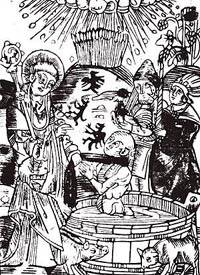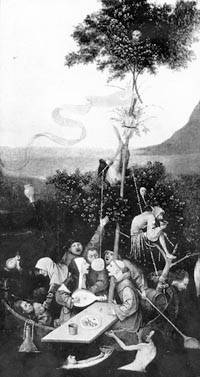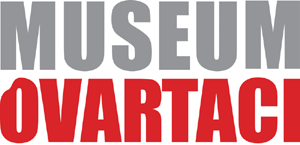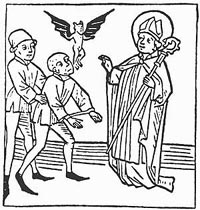
"Imbalance in bodily fluids"
(Human Pathology)
The classic Greek medical science around 400 BC had rid itself of superstition about possession by evil spirits. It was based on clinical observations of the sick and their symptoms and it sought to give coherent diagnoses. Melancholia, mania and phrenia are Greek words. Diseases were to be explained from nature. The Greeks believed that diseases were caused by a faulty composition of bodily fluids and they called this discipline human pathology. Human pathology claimed that imbalances of blood, bile, mucus and water (the basis for the four temperaments) made people sick – even insane. This imbalance prevented what the Greeks considered to be the ideal state of the human, a healthy mind in a healthy body. The Roman physician Galen from the second century A.D. systematized the human pathology. The treatment of insanity consisted, amongst other things, of hot baths, encouragements, herbs, rubbing the feet and moderate shock treatments. From the beginning of the Middle Ages human pathology was kept alive by the Arabs, as were many other examples of Greek thinking.
"Gal" is the Danish word for being mad.
The word Gal is known from Old Norse as ”garl” (noun) or ”galder” (verb) which means ”to scream”. It is the same word used in the contemporary Danish word “hanegal” which means cockcrow.
Raving mad
In the ancient North people could be labelled as either “raving mad” and would be put under restraint, or as ”insane” which was thought to be hereditary.
Evil Spirits
Evil spirits were sent by God, an example being King Saul’s melancholy. David dispersed the melancholy of the king by playing his harp, this being one of the earliest mentions of "music therapy".
Exorcism
In the Middle Ages the dominant Roman Catholic church adopted the ancient Greek world view into its dogma. According to the church the world was divided in the battle between God and Satan, between good and evil – virtue and sin. The insane were considered to be possessed by an evil spirit, and the treatment for that was exorcism of that same spirit.
Mediated by bishops, priests and monks, the exorcism consisted of invoking God’s holy power by prayer, sacred springs and especially by relics. Such procedures might well have resulted in a few individuals experiencing some short-term improvement.
Pathology of humans and demoniacal possession
It was possible to correlate human pathology and demoniacal possession. If a person was possessed (mentally ill) it was said that there was too much warm fluid in the body, and the devil does indeed appreciate something hot.

The Ship of Fools.
In the Middle Ages the course
of insanity was seen due to
a person’s promiscuous lifestyle.
Food, wine and pleasure-seeking
are here depicted in the painting
by Hieronymus Bosch
“The Ship of Fools” (1500).
The status of the insane in the Middle Ages
The status of the insane in the Middle Ages
From the early Middle Ages it was the family or clan, who were to take care of the insane. This meant that the closest member of the family had to take over legal responsibility for the insane, which then was declared incapable of managing their own affairs. If the insane person had committed a violent deed, the guardian had to pay for this. If the patient became unruly, the guardian could lock him up or tie him down with the permission of parliament.
The so-called Erik’s Zealand Act (approx. year 1200) contains the oldest written Danish provision on status of the insane (which today we define as being legally declared incapable of managing their own affairs).
”If it is found that a man has either a brother or a close kinsman who loses his wit and has land or property and it’s found necessary to prevent the mad person from selling his land, the person in charge should gather the best men in the village ... and go to the land registry to have the bans read that the mad person does not have his full wit”. This provision went into Danish Law in 1683.
Persons who were mildly mentally ill/mentally handicapped – a distinction was not made – could have lives as village fools. Although they probably were teased a lot, they remained, however, in the local environment.



